TouchView: Mid-Air Touch on Zoomable 2D View for Distant Freehand Selection on a Virtual Reality User Interface
Abstract
:1. Introduction
2. Techniques
2.1. Hybrid Ray
2.2. TouchView
- TouchView Screen: The virtual panel onto which targets are projected, allowing selection through indirect interaction. The TouchView Screen is constantly coupled with the user’s head movements and always covers the user’s entire field of view. The selection occurs when the index fingertip touches the surface of the TouchView Screen.
- Screen Cursor: The cursor that becomes visible when the user’s index finger approaches the TouchView Screen (Figure 1c). As the finger gets closer, the cursor shrinks and becomes more distinct. This cursor is positioned at the intersection between the TouchView Screen and an orthogonal vector from the user’s fingertip, indicating the point where selection can occur.
- Control Cursor: This invisible cursor is used to emit an invisible ray for target pointing. The Screen Cursor’s relative position on the TouchView Screen is mapped 1:1 to the Control Cursor, the movement of which occurs exclusively on the Control Plane (Figure 1c).
- Control Plane: The invisible interaction plane located in front of the view origin, where the Control Cursor moves. The Control Plane is constantly coupled with the user’s head movements, just like the TouchView Screen.
- View Origin: The origin point used to determine the view projected on the TouchView Screen. Initially, it is identical to the user’s head origin, but it moves forward when zooming in and backward when zooming out, based on the direction the user’s head is facing. The View Origin is constantly coupled with the user’s head movements.
- Rendered Cursor: The cursor for selection that appears as a red dot at the intersection point between the target object and the ray projected from the View Origin to the Control Cursor (Figure 1c). When selection occurs (i.e., when the user’s thrusting index fingertip passes through the TouchView Screen) while the Rendered Cursor is on the target surface, it results in a “target hit”. If the selection occurs while the Rendered Cursor is outside the target surface, it results in a “target miss”.
3. Method
3.1. Participants
3.2. Experimental Settings
3.3. Experimental Design
3.4. Experimental Procedure
3.5. Data Analysis
- 2 performance measures: task completion time and miss rate (the number of misses divided by the total number of selections)
- 7 perceived workload measures (NASA-TLX ratings): mental demand, physical demand, temporal demand, performance, effort, frustration, and weighted rating
- 4 behavioral measures: dominant/nondominant hand movement, head movement, distribution of selections made by each hand, and target visual angle
4. Results
4.1. Performance
4.2. Perceived Workload
4.3. User Behavior and Preference
5. Discussion
5.1. Addressing Limitations of ViewfinderVR with TouchView
5.2. Efficiency of Direct and Bimanual Touch Interaction
5.3. Drawbacks of View Magnification on Accuracy
5.4. Limitations and Future Work
6. Conclusions
Author Contributions
Funding
Institutional Review Board Statement
Informed Consent Statement
Data Availability Statement
Conflicts of Interest
Appendix A
| Measures | Source of Variation | ||||||||
|---|---|---|---|---|---|---|---|---|---|
| TQ | TS | TQ × TS | |||||||
| F | p | F | p | F | p | ||||
| Task completion time (s) | 45.19 | *** <0.001 | 0.290 | 213.62 | *** <0.001 | 0.689 | 9.88 | ** 0.003 | 0.082 |
| Miss rate (%) | 0.66 | 0.425 | 0.005 | 175.49 | *** <0.001 | 0.597 | 3.04 | 0.058 | 0.025 |
| Mental demand | 24.24 | *** <0.001 | 0.046 | 59.97 | *** <0.001 | 0.305 | 6.29 | ** 0.004 | 0.017 |
| Physical demand | 6.45 | * 0.019 | 0.016 | 36.80 | *** <0.001 | 0.226 | 5.17 | ** 0.010 | 0.015 |
| Temporal demand | 20.13 | *** <0.001 | 0.049 | 44.71 | *** <0.001 | 0.213 | 2.81 | 0.071 | 0.008 |
| Performance | 12.74 | ** 0.002 | 0.082 | 53.48 | *** <0.001 | 0.299 | 2.28 | 0.114 | 0.010 |
| Effort | 15.01 | *** <0.001 | 0.054 | 60.50 | *** <0.001 | 0.324 | 2.32 | 0.110 | 0.009 |
| Frustration | 0.78 | ** 0.003 | 0.030 | 47.68 | *** <0.001 | 0.245 | 6.66 | ** 0.003 | 0.021 |
| Weighted rating | 21.74 | *** <0.001 | 0.069 | 77.21 | *** <0.001 | 0.350 | 4.47 | * 0.017 | 0.013 |
| D hand movement (m) | 71.68 | *** <0.001 | 0.484 | 3.80 | * 0.030 | 0.037 | 2.03 | 0.143 | 0.019 |
| ND hand movement (m) | 23.18 | *** <0.001 | 0.215 | 2.67 | 0.080 | 0.024 | 11.43 | *** <0.001 | 0.084 |
| Head movement (m) | 7.60 | * 0.012 | 0.042 | 80.76 | *** <0.001 | 0.413 | 1.04 | 0.364 | 0.005 |
| Target VA (°) | 10.54 | ** 0.004 | 0.132 | 991.50 | *** <0.001 | 0.888 | 11.40 | *** <0.001 | 0.156 |
| Measures | Hybrid Ray | TouchView | ||||||
|---|---|---|---|---|---|---|---|---|
| All | 7.5° | 4.5° | 1.5° | All | 7.5° | 4.5° | 1.5° | |
| Task completion time (s) | 29.0 (16.8) | 17.7 (6.58) | 21.2 (5.56) | 48.2 (14.6) | 19.3 (10.5) | 11.1 (3.14) | 14.7 (3.28) | 32.0 (7.64) |
| Miss rate (%) | 16.8 (12.6) | 9.6 (8.0) | 10.0 (7.1) | 30.6 (8.4) | 15.8 (10.0) | 9.8 (6.2) | 11.1 (5.8) | 26.4 (7.8) |
| Mental demand | 39.3 (30.1) | 22.8 (23.2) | 31.1 (25.2) | 64.1 (24.9) | 29.5 (24.3) | 18.5 (19.7) | 23.9 (20.8) | 46.1 (23.5) |
| Physical demand | 33.8 (27.0) | 21.7 (20.9) | 25.7 (21.7) | 54.1 (26.3) | 28.3 (22.9) | 20.4 (20.7) | 23.5 (20.6) | 40.9 (22.5) |
| Temporal demand | 36.5 (28.0) | 24.3 (23.5) | 29.3 (23.4) | 55.9 (26.8) | 26.3 (23.3) | 17.6 (20.4) | 21.5 (22.5) | 39.8 (21.4) |
| Performance | 37.1 (29.5) | 22.0 (21.5) | 29.8 (25.9) | 59.6 (27.0) | 24.3 (21.9) | 13.5 (15.8) | 18.5 (17.8) | 40.9 (21.7) |
| Effort | 40.9 (30.2) | 25.2 (24.3) | 31.7 (24.4) | 65.9 (25.3) | 30.1 (25.6) | 16.5 (18.4) | 24.8 (23.3) | 48.9 (23.4) |
| Frustration | 30.4 (30.2) | 15.7 (21.1) | 22.2 (24.4) | 53.5 (30.5) | 22.3 (23.5) | 12.4 (16.8) | 18.7 (21.3) | 35.9 (25.7) |
| Weighted rating | 39.0 (28.3) | 23.2 (21.6) | 30.7 (22.8) | 63.1 (23.4) | 27.9 (22.4) | 16.4 (17.6) | 22.0 (18.9) | 45.4 (19.8) |
| D hand movement (m) | 0.86 (0.25) | 0.82 (0.27) | 0.80 (0.24) | 0.98 (0.22) | 1.89 (0.74) | 2.04 (0.83) | 1.67 (0.72) | 1.97 (0.62) |
| ND hand movement (m) | 0.39 (0.16) | 0.34 (0.13) | 0.32 (0.11) | 0.52 (0.16) | 0.87 (0.66) | 1.12 (0.85) | 0.85 (0.63) | 0.63 (0.32) |
| Head movement (m) | 0.38 (0.16) | 0.31 (0.12) | 0.32 (0.12) | 0.52 (0.15) | 0.43 (0.17) | 0.34 (0.11) | 0.36 (0.10) | 0.60 (0.17) |
| Original target VA (°) | 3.68 (2.01) | 6.12 (0.09) | 3.68 (0.07) | 1.23 (0.02) | 3.70 (2.03) | 6.15 (0.09) | 3.72 (0.05) | 1.22 (0.03) |
| Adjusted target VA (°) | NA | NA | NA | NA | 4.22 (1.83) | 6.06 (1.43) | 4.04 (1.10) | 2.55 (0.80) |
References
- LaViola, J.J., Jr.; Kruijff, E.; McMahan, R.P.; Bowman, D.; Poupyrev, I.P. 3D User Interfaces: Theory and Practice, 2nd ed.; Addison-Wesley Professional: Boston, MA, USA, 2017; ISBN 0134034325. [Google Scholar]
- Bowman, D.A.; Hodges, L.F. An Evaluation of Techniques for Grabbing and Manipulating Remote Objects in Immersive Virtual Environments. In Proceedings of the 1997 Symposium on Interactive 3D Graphics—SI3D ’97, New York, NY, USA, 27–30 April 1997; p. 35. [Google Scholar]
- Lee, S.; Seo, J.; Kim, G.J.; Park, C.-M. Evaluation of Pointing Techniques for Ray Casting Selection in Virtual Environments. In Proceedings of the Third International Conference on Virtual Reality and Its Application in Industry, Bellingham, WA, USA, 16–19 June 2003; pp. 38–44. [Google Scholar]
- Andujar, C.; Argelaguet, F. Anisomorphic Ray-Casting Manipulation for Interacting with 2D GUIs. Comput. Graph. 2007, 31, 15–25. [Google Scholar] [CrossRef]
- Bacim, F.; Kopper, R.; Bowman, D.A. Design and Evaluation of 3D Selection Techniques Based on Progressive Refinement. Int J. Hum. Comput. Stud. 2013, 71, 785–802. [Google Scholar] [CrossRef]
- Lindeman, R.W.; Sibert, J.L.; Hahn, J.K. Hand-Held Windows: Towards Effective 2D Interaction in Immersive Virtual Environments. In Proceedings of the IEEE Virtual Reality (Cat. No. 99CB36316), Washington, DC, USA, 13–17 March 1999; pp. 205–212. [Google Scholar]
- Steed, A.; Parker, C. 3d Selection Strategies for Head Tracked and Non-Head Tracked Operation of Spatially Immersive Displays. In Proceedings of the 8th International Immersive Projection Technology Workshop, Ames, IA, USA, 13–14 May 2004. [Google Scholar]
- Brasier, E.; Chapuis, O.; Ferey, N.; Vezien, J.; Appert, C. ARPads: Mid-Air Indirect Input for Augmented Reality. In Proceedings of the 2020 IEEE International Symposium on Mixed and Augmented Reality (ISMAR), Piscataway, NJ, USA, 9–13 November 2020; pp. 332–343. [Google Scholar]
- Herndon, K.P.; van Dam, A.; Gleicher, M. The Challenges of 3D Interaction. ACM SIGCHI Bull. 1994, 26, 36–43. [Google Scholar] [CrossRef]
- Cockburn, A.; Quinn, P.; Gutwin, C.; Ramos, G.; Looser, J. Air Pointing: Design and Evaluation of Spatial Target Acquisition with and without Visual Feedback. Int. J. Hum. Comput. Stud 2011, 69, 401–414. [Google Scholar] [CrossRef]
- Lu, Y.; Yu, C.; Shi, Y. Investigating Bubble Mechanism for Ray-Casting to Improve 3D Target Acquisition in Virtual Reality. In Proceedings of the 2020 IEEE Conference on Virtual Reality and 3D User Interfaces (VR), Piscataway, NJ, USA, 22–26 March 2020; pp. 35–43. [Google Scholar]
- Bowman, D.A.; Wingrave, C.; Campbell, J.; Ly, V. Using Pinch Gloves (TM) for Both Natural and Abstract Interaction Techniques in Virtual Environments; Department of Computer Science, Virginia Polytechnic Institute & State University: Blacksburg, VA, USA, 2001. [Google Scholar]
- Wolf, D.; Gugenheimer, J.; Combosch, M.; Rukzio, E. Understanding the Heisenberg Effect of Spatial Interaction: A Selection Induced Error for Spatially Tracked Input Devices. In Proceedings of the 2020 CHI Conference on Human Factors in Computing Systems, New York, NY, USA, 25–30 April 2020; pp. 1–10. [Google Scholar]
- Weise, M.; Zender, R.; Lucke, U. How Can I Grab That?: Solving Issues of Interaction in VR by Choosing Suitable Selection and Manipulation Techniques. i-com 2020, 19, 67–85. [Google Scholar] [CrossRef]
- Batmaz, A.U.; Seraji, M.R.; Kneifel, J.; Stuerzlinger, W. No Jitter Please: Effects of Rotational and Positional Jitter on 3D Mid-Air Interaction. In Intelligent Systems and Computing, Proceedings of the Future Technologies Conference (FTC) 2020, Vancouver, BC, Canada, 5–6 November 2020, Volume 2; Arai, K., Kapoor, S., Bhatia, R., Eds.; Springer: Berlin/Heidelberg, Germany, 2020; Volume 1289, pp. 792–808. [Google Scholar]
- Liang, J.; Green, M. JDCAD: A Highly Interactive 3D Modeling System. Comput. Graph. 1994, 18, 499–506. [Google Scholar] [CrossRef]
- Forsberg, A.; Herndon, K.; Zeleznik, R. Aperture Based Selection for Immersive Virtual Environments. In Proceedings of the 9th Annual ACM Symposium on User Interface Software and Technology—UIST ’96, New York, NY, USA, 6–8 November 1996; pp. 95–96. [Google Scholar]
- Kopper, R.; Bacim, F.; Bowman, D.A. Rapid and Accurate 3D Selection by Progressive Refinement. In Proceedings of the 3DUI 2011—IEEE Symposium on 3D User Interfaces 2011, Singapore, 19–20 March 2011. [Google Scholar]
- Cashion, J.; Wingrave, C.; LaViola, J.J. Dense and Dynamic 3D Selection for Game-Based Virtual Environments. IEEE Trans. Vis. Comput. Graph. 2012, 18, 634–642. [Google Scholar] [CrossRef]
- Baloup, M.; Pietrzak, T.; Casiez, G. RayCursor: A 3D Pointing Facilitation Technique Based on Raycasting. In Proceedings of the 2019 CHI Conference on Human Factors in Computing Systems, New York, NY, USA, 4–9 May 2019; pp. 1–12. [Google Scholar]
- Grossman, T.; Balakrishnan, R. The Design and Evaluation of Selection Techniques for 3D Volumetric Displays. In Proceedings of the 19th Annual ACM Symposium on User Interface Software and Technology—UIST ’06, New York, NY, USA, 15–18 October 2006; p. 3. [Google Scholar]
- Wingrave, C.A.; Bowman, D.A.; Ramakrishnan, N. Towards Preferences in Virtual Environment Interfaces. In Proceedings of the 8th EGVE 2002, Barcelona, Spain, 30–31 May 2002; pp. 63–72. [Google Scholar]
- Steinicke, F.; Ropinski, T.; Hinrichs, K. Object Selection in Virtual Environments Using an Improved Virtual Pointer Metaphor. In Computer Vision and Graphics; Springer: Dordrecht, The Netherlands, 2006; pp. 320–326. [Google Scholar]
- Cashion, J.; Wingrave, C.; LaViola, J.J. Optimal 3D Selection Technique Assignment Using Real-Time Contextual Analysis. In Proceedings of the 2013 IEEE Symposium on 3D User Interfaces (3DUI), Piscataway, NJ, USA, 16–17 March 2013; pp. 107–110. [Google Scholar]
- Grossman, T.; Balakrishnan, R. The Bubble Cursor: Enhancing Target Acquisition by Dynamic of the Cursor’s Activation Area. In Proceedings of the SIGCHI Conference on Human Factors in Computing Systems—CHI ’05, New York, NY, USA, 2–7 April 2005; p. 281. [Google Scholar]
- Vanacken, L.; Grossman, T.; Coninx, K. Exploring the Effects of Environment Density and Target Visibility on Object Selection in 3D Virtual Environments. In Proceedings of the 2007 IEEE Symposium on 3D User Interfaces, Piscataway, NJ, USA, 10–11 March 2007. [Google Scholar]
- Krüger, M.; Gerrits, T.; Römer, T.; Kuhlen, T.; Weissker, T. IntenSelect+: Enhancing Score-Based Selection in Virtual Reality. IEEE Trans. Vis. Comput. Graph. 2024, 30, 2829–2838. [Google Scholar] [CrossRef]
- Vogel, D.; Balakrishnan, R. Distant Freehand Pointing and Clicking on Very Large, High Resolution Displays. In Proceedings of the 18th Annual ACM Symposium on User Interface Software and Technology—UIST ’05, New York, NY, USA, 23–26 October 2005; p. 33. [Google Scholar]
- Kopper, R.; Bowman, D.A.; Silva, M.G.; McMahan, R.P. A Human Motor Behavior Model for Distal Pointing Tasks. Int. J. Hum. Comput. Stud. 2010, 68, 603–615. [Google Scholar] [CrossRef]
- Frees, S.; Kessler, G.D.; Kay, E. PRISM Interaction for Enhancing Control in Immersive Virtual Environments. ACM Trans. Comput. Hum. Interact. 2007, 14, 2. [Google Scholar] [CrossRef]
- König, W.A.; Gerken, J.; Dierdorf, S.; Reiterer, H. Adaptive Pointing—Design and Evaluation of a Precision Enhancing Technique for Absolute Pointing Devices. In Human-Computer Interaction—INTERACT 2009, Proceedings of the 12th IFIP TC 13 International Conference, Uppsala, Sweden, 24–28 August 2009, Proceedigns Part I; Lecture Notes in Computer Science (Including Subseries Lecture Notes in Artificial Intelligence and Lecture Notes in Bioinformatics); Springer: Berlin/Heidelberg, Germany, 2009; pp. 658–671. ISBN 3642036546. [Google Scholar]
- Gallo, L.; Ciampi, M.; Minutolo, A. Smoothed Pointing: A User-Friendly Technique for Precision Enhanced Remote Pointing. In Proceedings of the 2010 International Conference on Complex, Intelligent and Software Intensive Systems, Piscataway, NJ, USA, 15–18 February 2010; pp. 712–717. [Google Scholar]
- Foley, J.M.; Held, R. Visually Directed Pointing as a Function of Target Distance, Direction, and Available Cues. Percept Psychophys 1972, 12, 263–268. [Google Scholar] [CrossRef]
- Mayer, S.; Schwind, V.; Schweigert, R.; Henze, N. The Effect of Offset Correction and Cursor on Mid-Air Pointing in Real and Virtual Environments. In Proceedings of the 2018 CHI Conference on Human Factors in Computing Systems, New York, NY, USA, 21–26 April 2018; pp. 1–13. [Google Scholar]
- Plaumann, K.; Weing, M.; Winkler, C.; Müller, M.; Rukzio, E. Towards Accurate Cursorless Pointing: The Effects of Ocular Dominance and Handedness. Pers. Ubiquitous Comput. 2018, 22, 633–646. [Google Scholar] [CrossRef]
- Stoakley, R.; Conway, M.J.; Pausch, R. Virtual Reality on a WIM: Interactive Worlds in Miniature. In Proceedings of the Conference on Human Factors in Computing Systems, Denver, CO, USA, 7–11 May 1995; Volume 1, pp. 265–272. [Google Scholar]
- Pierce, J.S.; Stearns, B.C.; Pausch, R. Voodoo Dolls: Seamless Interaction at Multiple Scales in Virtual Environments. In Proceedings of the 1999 Symposium on Interactive 3D Graphics—SI3D ’99, New York, NY, USA, 26–28 April 1999; pp. 141–145. [Google Scholar]
- Wingrave, C.A.; Haciahmetoglu, Y.; Bowman, D.A. Overcoming World in Miniature Limitations by a Scaled and Scrolling WIM. In Proceedings of the 3D User Interfaces (3DUI’06), Piscataway, NJ, USA, 25–26 March 2006; pp. 11–16. [Google Scholar]
- Bowman, D.A.; Koller, D.; Hodges, L.F. Travel in Immersive Virtual Environments: An Evaluation of Viewpoint Motion Control Techniques. In Proceedings of the IEEE 1997 Annual International Symposium on Virtual Reality, Washington, DC, USA, 1–5 March 1997; pp. 45–52. [Google Scholar]
- Pohl, H.; Lilija, K.; McIntosh, J.; Hornbæk, K. Poros: Configurable Proxies for Distant Interactions in VR. In Proceedings of the 2021 CHI Conference on Human Factors in Computing Systems, New York, NY, USA, 8–13 May 2021; pp. 1–12. [Google Scholar]
- Schjerlund, J.; Hornbæk, K.; Bergström, J. Ninja Hands: Using Many Hands to Improve Target Selection in VR. In Proceedings of the 2021 CHI Conference on Human Factors in Computing Systems, New York, NY, USA, 8–13 May 2021; pp. 1–14. [Google Scholar]
- Broussard, D.; Borst, C.W. Tether-Handle Interaction for Retrieving Out-of-Range Objects in VR. In Proceedings of the 2023 IEEE Conference on Virtual Reality and 3D User Interfaces Abstracts and Workshops (VRW), Piscataway, NJ, USA, 25–29 March 2023; pp. 707–708. [Google Scholar]
- Natapov, D.; MacKenzie, I.S. The Trackball Controller: Improving the Analog Stick. In Proceedings of the International Academic Conference on the Future of Game Design and Technology—Futureplay ’10, New York, NY, USA, 6–7 May 2010; p. 175. [Google Scholar]
- Pierce, J.S.; Forsberg, A.S.; Conway, M.J.; Hong, S.; Zeleznik, R.C.; Mine, M.R. Image Plane Interaction Techniques in 3D Immersive Environments. In Proceedings of the 1997 Symposium on Interactive 3D Graphics—SI3D ’97, New York, NY, USA, 27–30 April 1997; p. 39. [Google Scholar]
- Teather, R.J.; Stuerzlinger, W. Pointing at 3d Target Projections with One-Eyed and Stereo Cursors. In Proceedings of the SIGCHI Conference on Human Factors in Computing Systems—CHI ’13, Paris, France, 27 April–2 May 2013. [Google Scholar]
- Ware, C.; Lowther, K. Selection Using a One-Eyed Cursor in a Fish Tank VR Environment. ACM Trans. Comput. -Hum. Interact. 1997, 4, 309–322. [Google Scholar] [CrossRef]
- Ramcharitar, A.; Teather, R. EZCursorVR: 2D Selection with Virtual Reality Head-Mounted Displays. In Proceedings of the Proceedings—Graphics Interface, Toronto, ON, Canada, 8–10 May 2018; pp. 114–121. [Google Scholar]
- Stoev, S.L.; Schmalstieg, D. Application and Taxonomy of Through-the-Lens Techniques. In Proceedings of the ACM Symposium on Virtual Reality Software and Technology—VRST ’02, New York, NY, USA, 11–13 November 2002; p. 57. [Google Scholar]
- Argelaguet, F.; Andujar, C. Visual Feedback Techniques for Virtual Pointing on Stereoscopic Displays. In Proceedings of the 16th ACM Symposium on Virtual Reality Software and Technology—VRST ’09, New York, NY, USA, 27–29 October 2009; p. 163. [Google Scholar]
- Clergeaud, D.; Guitton, P. Pano: Design and Evaluation of a 360° through-the-Lens Technique. In Proceedings of the 2017 IEEE Symposium on 3D User Interfaces (3DUI), Piscataway, NJ, USA, 18–19 March 2017; pp. 2–11. [Google Scholar]
- Li, N.; Zhang, Z.; Liu, C.; Yang, Z.; Fu, Y.; Tian, F.; Han, T.; Fan, M. VMirror: Enhancing the Interaction with Occluded or Distant Objects in VR with Virtual Mirrors. In Proceedings of the 2021 CHI Conference on Human Factors in Computing Systems, New York, NY, USA, 8–13 May 2021; pp. 1–11. [Google Scholar]
- Surale, H.B.; Gupta, A.; Hancock, M.; Vogel, D. TabletInVR: Exploring the Design Space for Using a Multi-Touch Tablet in Virtual Reality. In Proceedings of the 2019 CHI Conference on Human Factors in Computing Systems, New York, NY, USA, 4–9 May 2019; pp. 1–13. [Google Scholar]
- Mossel, A.; Venditti, B.; Kaufmann, H. DrillSample: Precise Selection in Dense Handheld Augmented Reality Environments. In Proceedings of the Virtual Reality International Conference: Laval Virtual, New York, NY, USA, 20–22 March 2013; pp. 1–10. [Google Scholar]
- Yin, J.; Fu, C.; Zhang, X.; Liu, T. Precise Target Selection Techniques in Handheld Augmented Reality Interfaces. IEEE Access 2019, 7, 17663–17674. [Google Scholar] [CrossRef]
- Bai, H.; Lee, G.A.; Billinghurst, M. Freeze View Touch and Finger Gesture Based Interaction Methods for Handheld Augmented Reality Interfaces. In Proceedings of the 27th Conference on Image and Vision Computing New Zealand—IVCNZ ’12, New York, NY, USA, 26–28 November 2012; p. 126. [Google Scholar]
- Arshad, H.; Chowdhury, S.A.; Chun, L.M.; Parhizkar, B.; Obeidy, W.K. A Freeze-Object Interaction Technique for Handheld Augmented Reality Systems. Multimed Tools Appl. 2016, 75, 5819–5839. [Google Scholar] [CrossRef]
- McDonald, B.; Zhang, Q.; Nanzatov, A.; Peña-Castillo, L.; Meruvia-Pastor, O. SmartVR Pointer: Using Smartphones and Gaze Orientation for Selection and Navigation in Virtual Reality. Sensors 2024, 24, 5168. [Google Scholar] [CrossRef]
- Bergström, J.; Dalsgaard, T.-S.; Alexander, J.; Hornbæk, K. How to Evaluate Object Selection and Manipulation in VR? Guidelines from 20 Years of Studies. In Proceedings of the 2021 CHI Conference on Human Factors in Computing Systems, New York, NY, USA, 8–13 May 2021; pp. 1–20. [Google Scholar]
- Henrikson, R.; Grossman, T.; Trowbridge, S.; Wigdor, D.; Benko, H. Head-Coupled Kinematic Template Matching: A Prediction Model for Ray Pointing in VR. In Proceedings of the 2020 CHI Conference on Human Factors in Computing Systems, New York, NY, USA, 25–30 April 2020; pp. 1–14. [Google Scholar]
- Yu, D.; Liang, H.-N.; Lu, X.; Fan, K.; Ens, B. Modeling Endpoint Distribution of Pointing Selection Tasks in Virtual Reality Environments. ACM Trans. Graph. 2019, 38, 1–13. [Google Scholar] [CrossRef]
- Meta Raycasting. Available online: https://developer.oculus.com/resources/hands-design-bp/#raycasting (accessed on 15 May 2024).
- Kim, W.; Xiong, S. ViewfinderVR: Configurable Viewfinder for Selection of Distant Objects in VR. Virtual Real. 2022, 26, 1573–1592. [Google Scholar] [CrossRef]
- Berwaldt, N.L.P.; Di Domenico, G.; Pozzer, C.T. Virtual MultiView Panels for Distant Object Interaction and Navigation in Virtual Reality. In Proceedings of the Symposium on Virtual and Augmented Reality, New York, NY, USA, 6–9 November 2023; pp. 88–95. [Google Scholar]
- Jota, R.; Nacenta, M.A.; Jorge, J.A.; Carpendale, S.; Greenberg, S. A Comparison of Ray Pointing Techniques for Very Large Displays. In Proceedings of the Proceedings—Graphics Interface, Toronto, ON, Canada, 31 May–2 June 2010. [Google Scholar]
- Alsop, T. Extended Reality (XR) Headset Vendor Shipment Share Worldwide from 2020 to 2023, by Quarter. Available online: https://www.statista.com/statistics/1222146/xr-headset-shipment-share-worldwide-by-brand/ (accessed on 14 May 2024).
- Shin, G.; Zhu, X. User Discomfort, Work Posture and Muscle Activity While Using a Touchscreen in a Desktop PC Setting. Ergonomics 2011, 54, 733–744. [Google Scholar] [CrossRef]
- Penumudi, S.A.; Kuppam, V.A.; Kim, J.H.; Hwang, J. The Effects of Target Location on Musculoskeletal Load, Task Performance, and Subjective Discomfort during Virtual Reality Interactions. Appl. Ergon. 2020, 84, 103010. [Google Scholar] [CrossRef]
- Lin, M.Y.; Barbir, A.; Dennerlein, J.T. Evaluating Biomechanics of User-Selected Sitting and Standing Computer Workstation. Appl Ergon 2017, 65, 382–388. [Google Scholar] [CrossRef] [PubMed]
- Han, S.; Liu, B.; Cabezas, R.; Twigg, C.D.; Zhang, P.; Petkau, J.; Yu, T.-H.; Tai, C.-J.; Akbay, M.; Wang, Z.; et al. MEgATrack: Monochrome Egocentric Articulated Hand-Tracking for Virtual Reality. ACM Trans. Graph. 2020, 39, 87:1–87:13. [Google Scholar] [CrossRef]
- Poupyrev, I.; Ichikawa, T.; Weghorst, S.; Billinghurst, M. Egocentric Object Manipulation in Virtual Environments: Empirical Evaluation of Interaction Techniques. Comput. Graph. Forum 1998, 17, 41–52. [Google Scholar] [CrossRef]
- Moore, A.G.; Hatch, J.G.; Kuehl, S.; McMahan, R.P. VOTE: A Ray-Casting Study of Vote-Oriented Technique Enhancements. Int. J. Hum. Comput. Stud. 2018, 120, 36–48. [Google Scholar] [CrossRef]
- Kin, K.; Agrawala, M.; DeRose, T. Determining the Benefits of Direct-Touch, Bimanual, and Multifinger Input on a Multitouch Workstation. In Proceedings of the Graphics Interface 2009 (GI ’09), Kelowna, BC, Canada, 25–27 May 2009; pp. 119–124. [Google Scholar]
- Hart, S.G.; Staveland, L.E. Development of NASA-TLX (Task Load Index): Results of Empirical and Theoretical Research. In Advances in Human Psychology: Human Mental Workload; Elsevier Science: Amsterdam, The Netherlands, 1988; pp. 139–183. [Google Scholar]
- Olejnik, S.; Algina, J. Generalized Eta and Omega Squared Statistics: Measures of Effect Size for Some Common Research Designs. Psychol. Methods 2003, 8, 434–447. [Google Scholar] [CrossRef]
- McLaughlin, A.C.; Rogers, W.A.; Fisk, A.D. Using Direct and Indirect Input Devices: Attention Demands and Age-Related Differences. ACM Trans. Comput. Hum. Interact. 2009, 16, 1–15. [Google Scholar] [CrossRef]
- Charness, N.; Holley, P.; Feddon, J.; Jastrzembski, T. Light Pen Use and Practice Minimize Age and Hand Performance Differences in Pointing Tasks. Hum. Factors J. Hum. Factors Ergon. Soc. 2004, 46, 373–384. [Google Scholar] [CrossRef]
- Murata, A.; Iwase, H. Usability of Touch-Panel Interfaces for Older Adults. Hum. Factors J. Hum. Factors Ergon. Soc. 2005, 47, 767–776. [Google Scholar] [CrossRef]
- Wickens, C. The Structure of Attentional Resources. In Attention and Performance Viii; Nickerson, R.S., Ed.; Psychology Press: New York, NY, USA, 1980; ISBN 9781315802961. [Google Scholar]
- Jang, S.; Stuerzlinger, W.; Ambike, S.; Ramani, K. Modeling Cumulative Arm Fatigue in Mid-Air Interaction Based on Perceived Exertion and Kinetics of Arm Motion. In Proceedings of the 2017 CHI Conference on Human Factors in Computing Systems—CHI ’17, New York, NY, USA, 6–11 May 2017; pp. 3328–3339. [Google Scholar]
- Liu, Z.; Vogel, D.; Wallace, J.R. Applying the Cumulative Fatigue Model to Interaction on Large, Multi-Touch Displays. In Proceedings of the 7th ACM International Symposium on Pervasive Displays, New York, NY, USA, 6–8 June 2018; pp. 1–9. [Google Scholar]
- Hincapié-Ramos, J.D.; Guo, X.; Moghadasian, P.; Irani, P. Consumed Endurance: A Metric to Quantify Arm Fatigue of Mid-Air Interactions. In Proceedings of the SIGCHI Conference on Human Factors in Computing Systems, New York, NY, USA, 26 April–1 May 2014; pp. 1063–1072. [Google Scholar]
- Watson, D.; Hancock, M.; Mandryk, R.L.; Birk, M. Deconstructing the Touch Experience. In Proceedings of the 2013 ACM International Conference on Interactive Tabletops and Surfaces, New York, NY, USA, 6–9 October 2013; pp. 199–208. [Google Scholar]
- Sears, A.; Shneiderman, B. High Precision Touchscreens: Design Strategies and Comparisons with a Mouse. Int. J. Man. Mach. Stud. 1991, 34, 593–613. [Google Scholar] [CrossRef]
- Forlines, C.; Wigdor, D.; Shen, C.; Balakrishnan, R. Direct-Touch vs. Mouse Input for Tabletop Displays. In Proceedings of the SIGCHI Conference on Human Factors in Computing Systems, New York, NY, USA, 28 April–3 May 2007; pp. 647–656. [Google Scholar]
- Kennedy, D.M.; Wang, C.; Wang, Y.; Shea, C.H. The Influence of Accuracy Constraints on Bimanual and Unimanual Sequence Learning. Neurosci. Lett. 2021, 751, 135812. [Google Scholar] [CrossRef]
- Wang, C.; Boyle, J.B.; Dai, B.; Shea, C.H. Do Accuracy Requirements Change Bimanual and Unimanual Control Processes Similarly? Exp. Brain. Res. 2017, 235, 1467–1479. [Google Scholar] [CrossRef] [PubMed]
- Helmuth, L.L.; Ivry, R.B. When Two Hands Are Better than One: Reduced Timing Variability during Bimanual Movements. J. Exp. Psychol. Hum. Percept. Perform. 1996, 22, 278–293. [Google Scholar] [CrossRef] [PubMed]
- Drewing, K.; Aschersleben, G. Reduced Timing Variability during Bimanual Coupling: A Role for Sensory Information. Q. J. Exp. Psychol. Sect. A 2003, 56, 329–350. [Google Scholar] [CrossRef] [PubMed]
- Corradini, A.; Cohen, P.R. Multimodal Speech-Gesture Interface for Handfree Painting on a Virtual Paper Using Partial Recurrent Neural Networks as Gesture Recognizer. In Proceedings of the 2002 International Joint Conference on Neural Networks. IJCNN’02 (Cat. No.02CH37290), Piscataway, NJ, USA, 12–17 May 2002; pp. 2293–2298. [Google Scholar]
- Yu, D.; Zhou, Q.; Newn, J.; Dingler, T.; Velloso, E.; Goncalves, J. Fully-Occluded Target Selection in Virtual Reality. IEEE Trans. Vis. Comput. Graph. 2020, 26, 3402–3413. [Google Scholar] [CrossRef]
- Sidenmark, L.; Clarke, C.; Zhang, X.; Phu, J.; Gellersen, H. Outline Pursuits: Gaze-Assisted Selection of Occluded Objects in Virtual Reality. In Proceedings of the 2020 CHI Conference on Human Factors in Computing Systems, New York, NY, USA, 25–30 April 2020; pp. 1–13. [Google Scholar]
- Lee, J.-J.; Park, J.-M. 3D Mirrored Object Selection for Occluded Objects in Virtual Environments. IEEE Access 2020, 8, 200259–200274. [Google Scholar] [CrossRef]
- Schneider, D.; Biener, V.; Otte, A.; Gesslein, T.; Gagel, P.; Campos, C.; Čopič Pucihar, K.; Kljun, M.; Ofek, E.; Pahud, M.; et al. Accuracy Evaluation of Touch Tasks in Commodity Virtual and Augmented Reality Head-Mounted Displays. In Proceedings of the Symposium on Spatial User Interaction, New York, NY, USA, 9 November 2021; pp. 1–11. [Google Scholar]
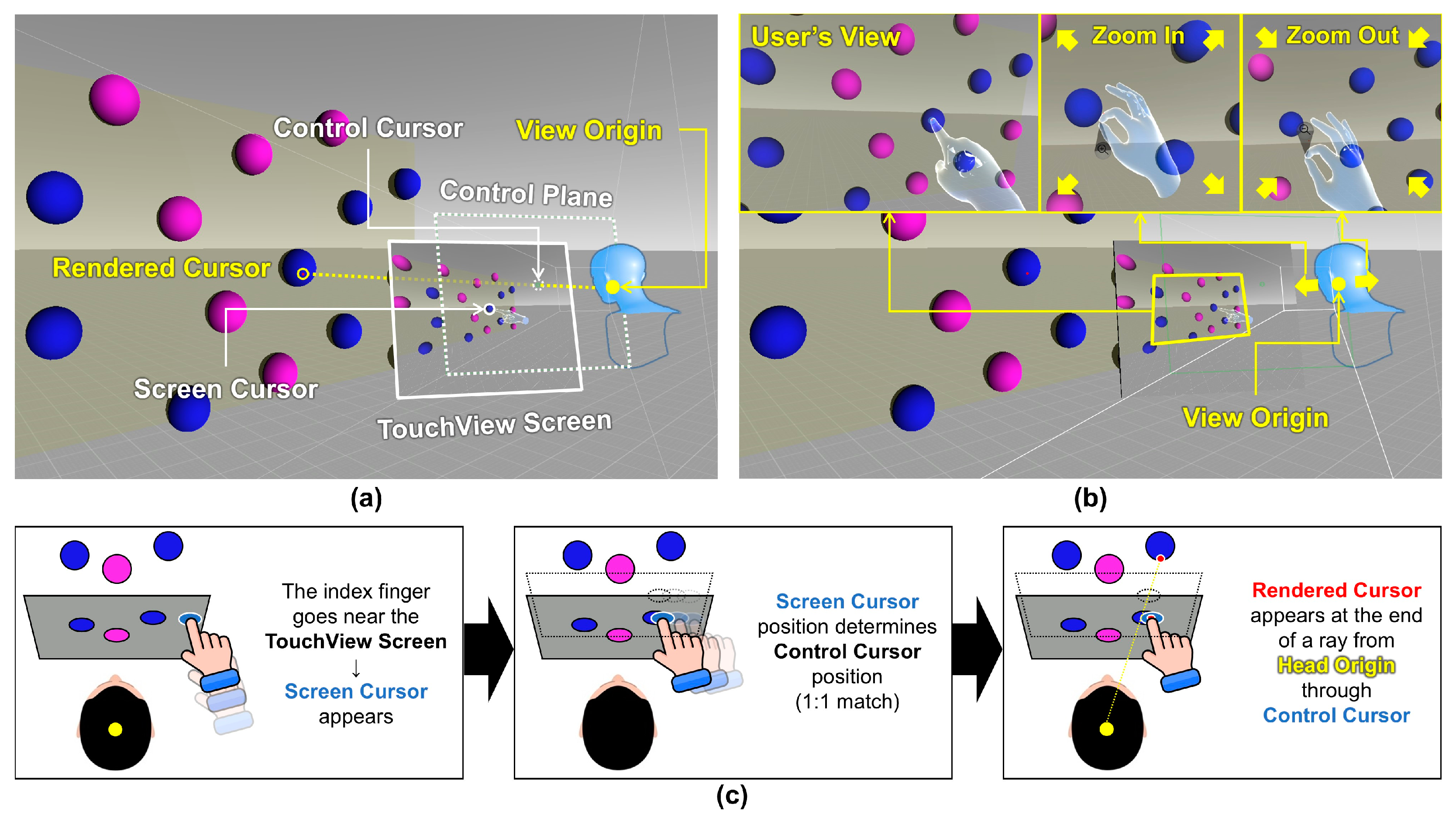

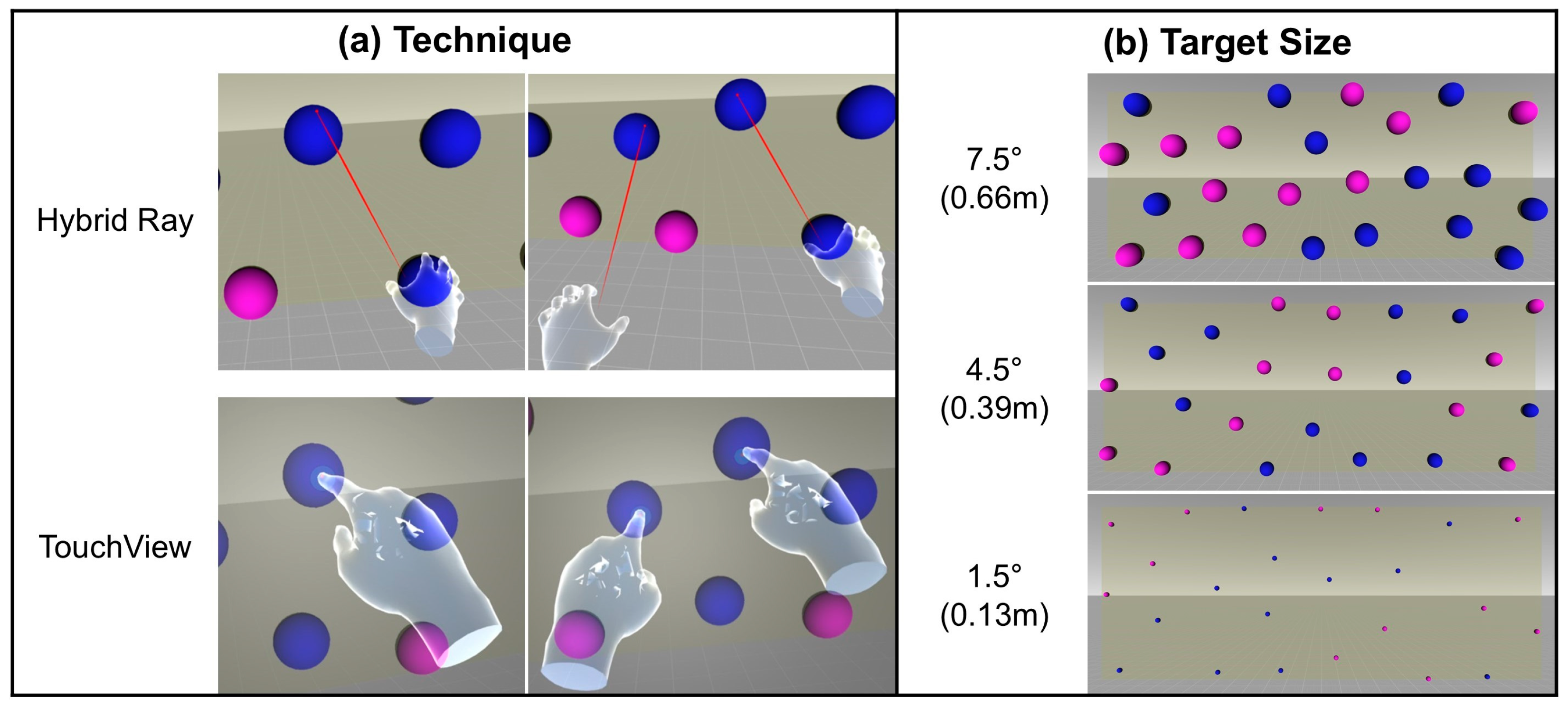
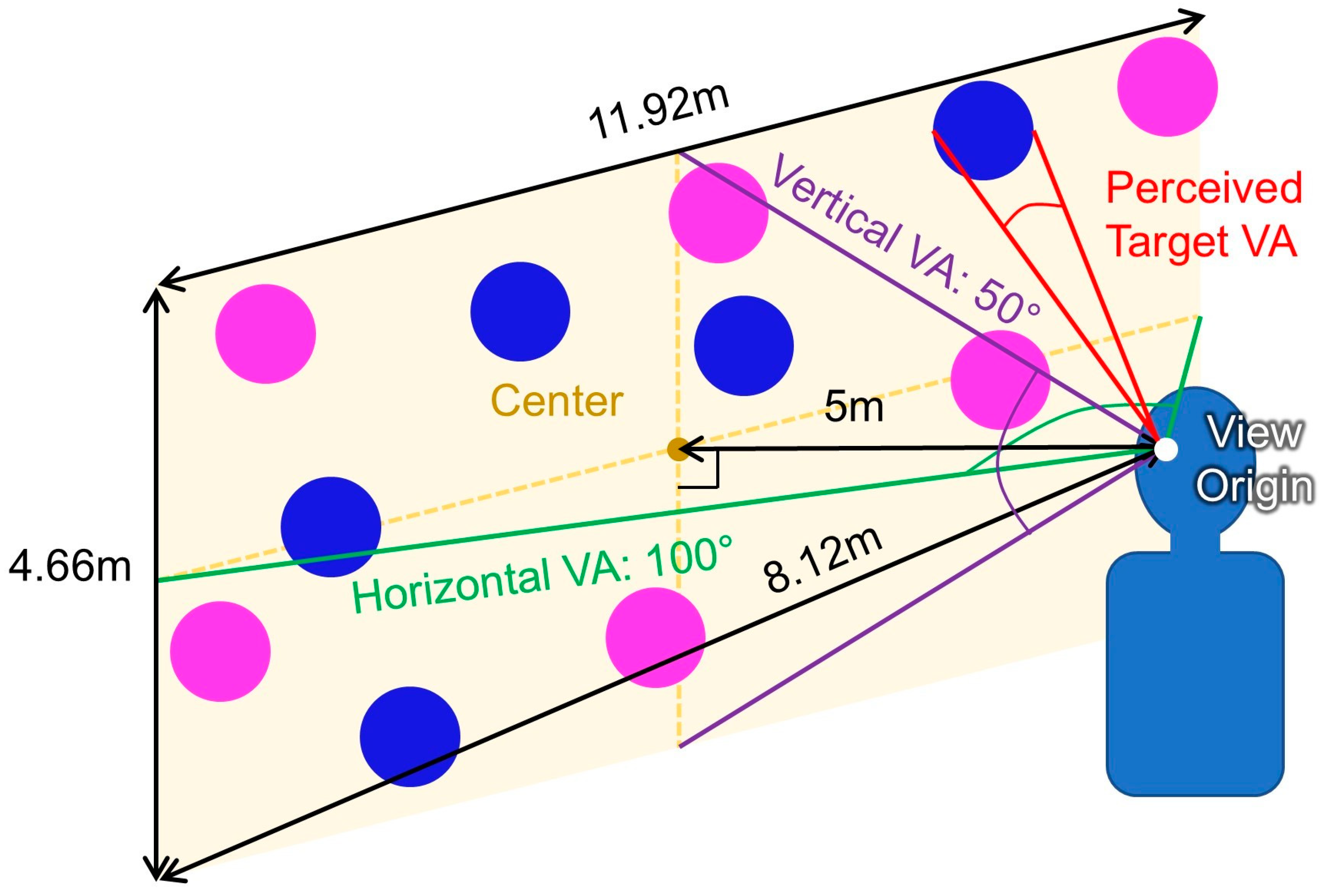


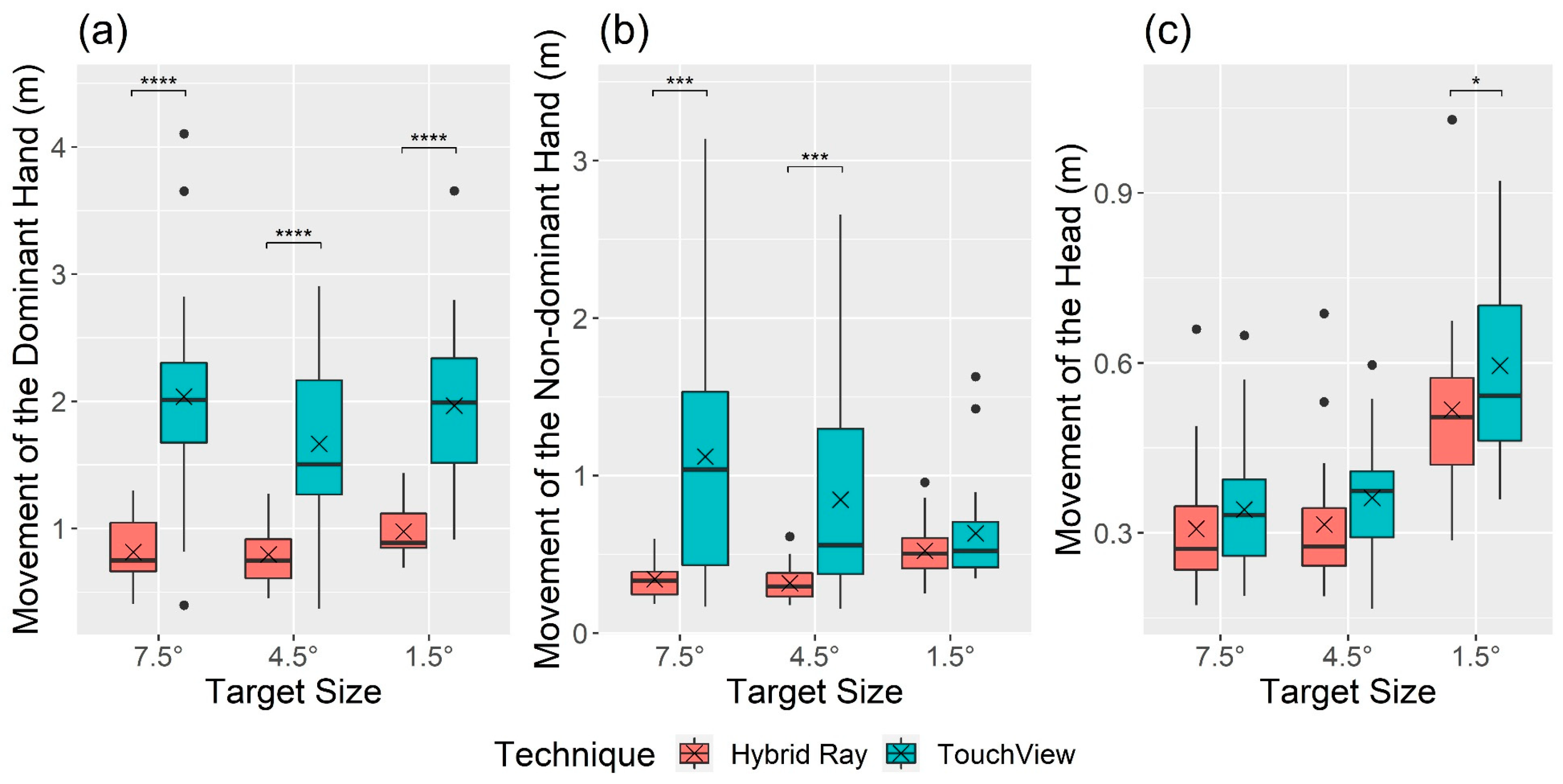
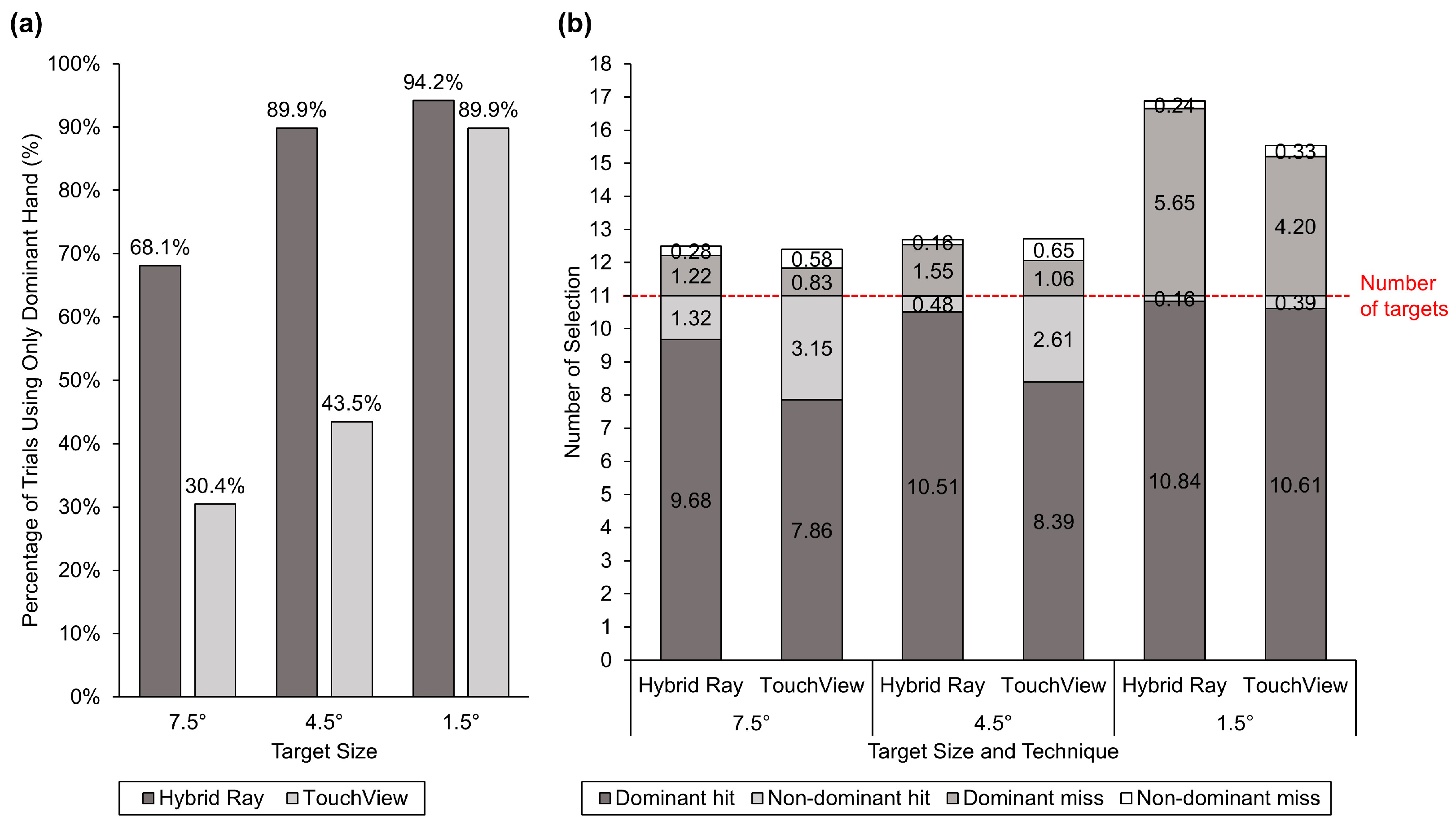
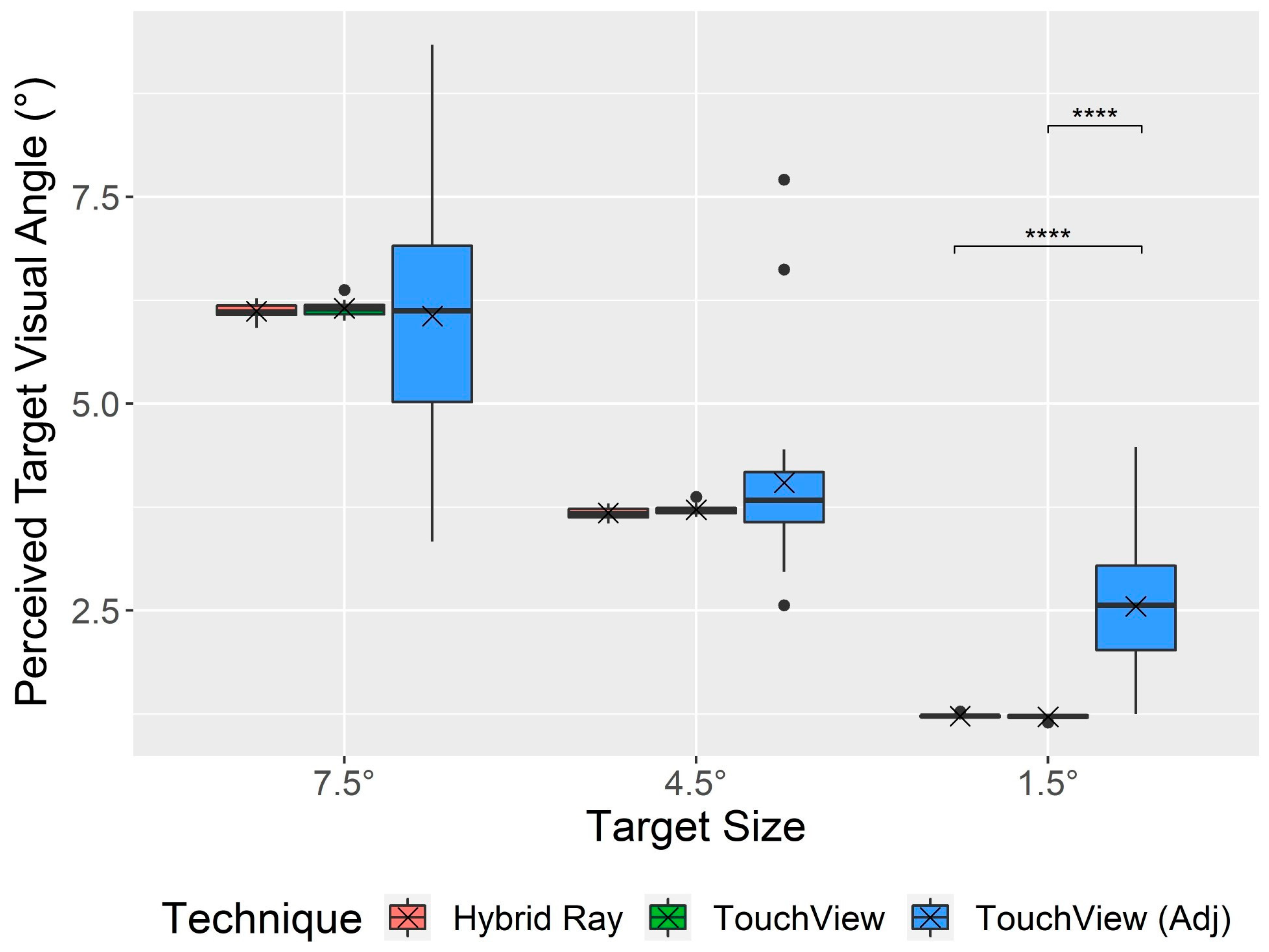

Disclaimer/Publisher’s Note: The statements, opinions and data contained in all publications are solely those of the individual author(s) and contributor(s) and not of MDPI and/or the editor(s). MDPI and/or the editor(s) disclaim responsibility for any injury to people or property resulting from any ideas, methods, instructions or products referred to in the content. |
© 2024 by the authors. Licensee MDPI, Basel, Switzerland. This article is an open access article distributed under the terms and conditions of the Creative Commons Attribution (CC BY) license (https://creativecommons.org/licenses/by/4.0/).
Share and Cite
Kim, W.; Xiong, S. TouchView: Mid-Air Touch on Zoomable 2D View for Distant Freehand Selection on a Virtual Reality User Interface. Sensors 2024, 24, 7202. https://doi.org/10.3390/s24227202
Kim W, Xiong S. TouchView: Mid-Air Touch on Zoomable 2D View for Distant Freehand Selection on a Virtual Reality User Interface. Sensors. 2024; 24(22):7202. https://doi.org/10.3390/s24227202
Chicago/Turabian StyleKim, Woojoo, and Shuping Xiong. 2024. "TouchView: Mid-Air Touch on Zoomable 2D View for Distant Freehand Selection on a Virtual Reality User Interface" Sensors 24, no. 22: 7202. https://doi.org/10.3390/s24227202
APA StyleKim, W., & Xiong, S. (2024). TouchView: Mid-Air Touch on Zoomable 2D View for Distant Freehand Selection on a Virtual Reality User Interface. Sensors, 24(22), 7202. https://doi.org/10.3390/s24227202







